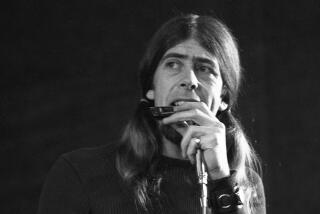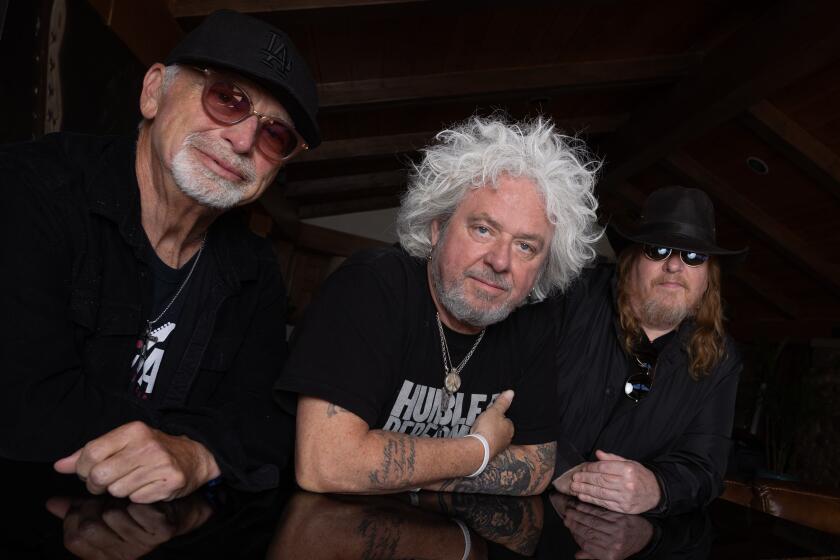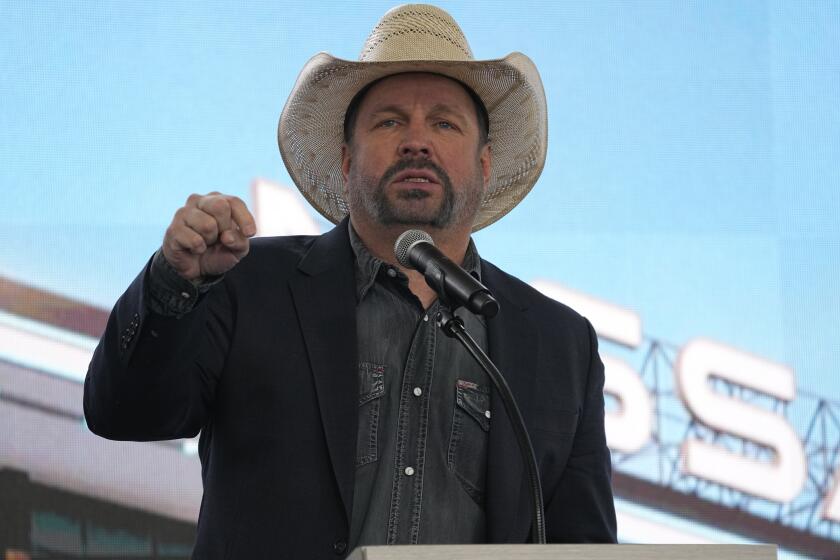Attention Must Be Paid to West Coast Musicians
Southern California doesn’t have the jazz singularity of New York City. There can only be one Big Apple. Nor, for that matter, does it have the territorial identity of some other cities--Chicago and Kansas City as fountainheads of jazz-blues, New Orleans as the genesis of it all.
But Los Angeles does have Central Avenue, with the decades of music and culture associated with that storied thoroughfare. It also has jazz artists whose abilities are second to none. Do they get the attention East Coast artists receive? With the exception of such well-established national artists as Herbie Hancock, they generally do not. So it’s not surprising that many gifted young players, born in the Southland, feel they must spend a few years in Manhattan to institute some sort of connection to, and visibility in, the jazz establishment.
For the record:
12:00 a.m. April 24, 2002 FOR THE RECORD
Los Angeles Times Wednesday April 24, 2002 Home Edition Main News Part A Page 2 A2 Desk 1 inches; 24 words Type of Material: Correction
Saxophonist--In a Sunday Calendar review of Sherman Ferguson’s “Jazz Union” recording, soprano saxophonist Louis Van Taylor was misidentified as Louis Van Nelson.
For the Record
Los Angeles Times Sunday April 28, 2002 Home Edition Calendar Part F Page 2 Calendar Desk 1 inches; 22 words Type of Material: Correction
Musician’s name-The April 21 Sunday Calendar review of Sherman Ferguson’s ‘Jazz Union’ listed the wrong last name for soprano saxophonist Louis Van Taylor.
All of which makes it difficult for the many talented, mature artists who live in the area. Record deals are difficult, if not impossible, to come by--even more so in the current state of the recording business. A remarkable number of players--many of whom are gifted enough to be fully competitive with major name artists--have had to display their wares on small record labels or by releasing their own albums.
How good are those often obscure CDs? Here’s a sampling of some current releases:
Peter Erskine, Alan Pasqua, Dave Carpenter, “Badlands” (***1/2, Fuzzy Music). The long-term relationship of these three veteran artists shows in every beautifully integrated note of this superb album. At first glance, the trio seems to have taken on a somewhat daunting task--in terms of audience receptivity--by offering a program consisting almost exclusively of originals by the members. (The sole exception is the standard “You and the Night and the Music.”)
But the selections--five by Pasqua, two each by Erskine and Carpenter--unfold with such engaging musicality and the performance level is so high that any question regarding the unfamiliarity of the material becomes irrelevant. The interaction among the three players is stunning, with Erskine’s percussion and Carpenter’s bass work serving as integral musical elements rather than simple rhythmic accompaniment.
The pieces have distinctly atmospheric qualities. Several of pianist Pasqua’s works--especially “Surrender” and “Daddy, What Is God’s Last Name” (with the latter sounding in places like a melodic inversion of the former)--resonate with classical references. At its best, the playing, individually and collectively, is a definitive model of how far this classic instrumentation has come since the days of the Bill Evans trios.
Jon Mayer, “Full Circle” (***1/2, Reservoir Records). It’s an utter mystery why Mayer, 63, has not had a more visible career--even though the pianist has recorded or performed with everyone from Jackie McLean and John Coltrane to Chet Baker and Freddie Hubbard. A consistently inventive player with a rich harmonic imagination and an innately upbeat sense of swing, he is always a pleasure to hear. On this album, perhaps because he was stimulated by recording in the energetic surroundings of his native New York City with bassist Rufus Reid and drummer Victor Lewis, he plays with even more density and texture than in his local gigs.
The album is filled with lofty achievements, among them a beautifully harmonized rendering of “Stolen Moments” and a pensive version of J.J. Johnson’s “Lament.” In a more upbeat vein, there are highly energetic, rhythmically in-the-pocket romps through “Night and Day” and “Falling in Love.” Here too, echoes of Bill Evans are heard, especially in Mayer’s loose, swinging rendering of “I Should Care.” In this case, however, the association is not surprising, since Evans and Mayer were in New York in the late ‘50s, exploring similar musical territory, with Mayer eventually replacing Evans in the Tony Scott Quartet.
Bill Cunliffe, “The Bill Cunliffe Trio Live at Bernie’s” (***, Groove Note). No, the title does not refer to an appearance at a mysterious Southland jazz venue. “Bernie’s” is actually Bernie Grundman Mastering Studio, a virtual Los Angeles shrine to record mastering, but never before used for an actual recording. “Live” identifies the process, in which pianist Cunliffe, with bassist Darek Oleszkiewicz (sometimes known as Darek Oles) and drummer Joe La Barbera, recorded live to disc. (There were actually dual simultaneous recordings--an analog version for an eventual LP release, and a digital version for CD and Super Audio CD).
The upbeat tone of the album is set early in a groove-driven version of Duke Ellington’s “Satin Doll,” followed by an unexpectedly high-voltage reading of Evans’ melodious “Waltz for Debby” (done in 4/4 rather than waltz time) and continuing with a brisk “The Way You Look Tonight.”
But the most interesting aspect is the far-ranging choice of material.
In the mischievously titled “Amusing Paramours,” Cunliffe disguises a familiar standard by building his own tune on the chords of “My Funny Valentine.” Other numbers rarely heard in a jazz setting: Rod McKuen’s “Jean” and John Lennon’s “Imagine.”
Perhaps most interesting of all is the manner in which Cunliffe captures the lyricism in a movement from Samuel Barber’s “Excursions” and the pensive qualities of his own “Ireland,” honoring English composer John Ireland.
Sherman Ferguson, “Jazz Union” (***, jazz/a/sance Records. Visit Southland jazz clubs for a week or two, and it’s very likely that Ferguson--one of the area’s A-list drummers--will be on stage at one place or another. His popularity traces directly to his versatility and his capacity to adapt to different musical settings. “Jazz Union,” his debut album as a leader, has similar strengths.
There is, first of all, an attractive choice of repertoire, from Johnny Griffin’s funky “Callitwhachawanna” to a sensual arrangement of Billy Strayhorn’s “Lush Life” revolving around Ferguson’s soulful mallet drumming. Oliver Nelson’s “Black, Brown and Beautiful” features well-crafted segments in which Louis Van Nelson’s soprano saxophone floats over Trevor Ware’s bowed bass line.
Each tune benefits from the surging rhythms of Ferguson’s percussion. The album peaks in the final track, “Spirit of Higgins,” a stirring group improvisation dedicated to another great Southland jazz drummer, the late Billy Higgins.
Leslie Baker, “Askew Two” (**1/2, Ranch Cabin Records, P.O. Box 1018, Glendale, CA 91209). Baker is a jazz rarity--a female bassist. Her resume lists dozens of gigs and recordings in a variety of genres with artists ranging from blues performers Willie Dixon and Lowell Fulson to jazz artists Ricky Woodard and Oscar Brown Jr.
The core of her second CD is the trio that includes pianist Phil Wright and drummer Billy Paul. Baker’s generally solid bass playing is well displayed in the way she delivers the melody of “I’m Beginning to See the Light” and an upbeat rendering of “Broadway” (in which she has the opportunity to display a walking-bass style deeply influenced by her teacher, the late great Red Callender).
Other highlights include the guitar and vocal work of Earl Alexander on “I Could Write a Book” and Baker’s original “Earthquake Blues,” Suzanne Spinoza’s lovely vocal rendering of another Baker original, “Rain Dance,” and Baker stepping up to the microphone to sing a spirited version of “Sometimes I’m Happy.”
Don Heckman writes frequently about jazz for The Times.
More to Read
The biggest entertainment stories
Get our big stories about Hollywood, film, television, music, arts, culture and more right in your inbox as soon as they publish.
You may occasionally receive promotional content from the Los Angeles Times.










